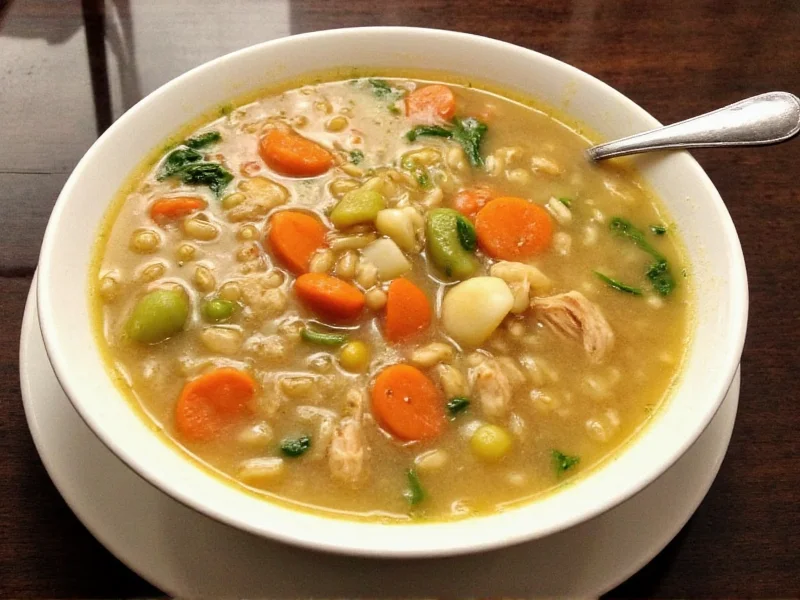For generations, chicken barley soup has been cherished as a restorative meal that combines the familiar comfort of chicken soup with the wholesome benefits of whole grains. This versatile dish works equally well as a weeknight dinner, meal prep staple, or remedy for cold weather. The magic happens when the barley releases its natural starches during cooking, creating a velvety broth that coats each ingredient while maintaining distinct textures.
Why Barley Makes the Perfect Soup Grain
When exploring how to make chicken barley soup from scratch, understanding barley's unique properties is essential. Pearl barley, the most common variety for soups, has had its outer hull removed while retaining most nutrients. Unlike rice or pasta, barley maintains its structure through multiple reheating cycles, making it ideal for leftovers. The grain's soluble fiber content not only thickens the broth naturally but also provides prebiotic benefits that support gut health.
Nutritional Advantages of Chicken Barley Soup
This comforting dish delivers a balanced nutritional profile that outperforms many traditional soups. The combination of lean protein from chicken, complex carbohydrates from barley, and vitamins from vegetables creates a complete meal that satisfies without excessive calories. Barley's high fiber content (about 6 grams per cooked cup) promotes satiety and helps regulate digestion, while the soup's liquid base contributes to hydration.
| Nutrient | Per Serving (1.5 cups) | Daily Value % |
|---|---|---|
| Calories | 220 | 11% |
| Protein | 18g | 36% |
| Fiber | 5g | 20% |
| Vitamin A | 4500 IU | 90% |
| Vitamin C | 15mg | 25% |
Essential Ingredients for Authentic Flavor
The best barley for chicken soup requires careful ingredient selection. Start with bone-in chicken pieces for superior flavor—thighs and drumsticks work better than breasts as they remain tender during longer cooking. Fresh mirepoix (carrots, celery, onions) forms the flavor foundation, while garlic and herbs like thyme and parsley add depth. When choosing barley, opt for pearl barley rather than hulled barley for faster cooking and better texture in soup applications.
Step-by-Step Cooking Process
Mastering chicken barley soup cooking time prevents mushy grains. First, simmer chicken with aromatics for 30 minutes, then remove and shred. Sauté vegetables until softened, add rinsed barley and broth, and cook 25-30 minutes until barley is tender but chewy. Return chicken to the pot and finish with fresh herbs. The critical timing element is adding barley early enough to cook properly but not so early that it disintegrates.
Avoiding Common Preparation Mistakes
Many home cooks make the error of adding barley too early or using instant barley, which turns to mush. Always rinse pearl barley before adding to remove excess starch that could make the soup gluey. Another frequent issue is over-salting at the beginning—barley absorbs salt during cooking, so season gradually. For optimal texture, add delicate vegetables like peas or spinach during the last 5 minutes of cooking.
Proper Storage and Reheating Techniques
Chicken barley soup storage tips ensure quality preservation. Cool soup completely before refrigerating in airtight containers for up to 5 days. The barley will continue absorbing liquid, so you'll need to add broth when reheating. For freezing, leave out the barley initially, freeze the base, then add freshly cooked barley when reheating for best texture. Reheat gently on the stove rather than in a microwave to maintain ingredient integrity.
Adapting the Recipe for Dietary Needs
Creating gluten-free chicken barley soup alternatives requires substituting the grain. While barley contains gluten, quinoa or brown rice provide similar heartiness with gluten-free benefits. For vegetarian versions, replace chicken broth with mushroom broth and add white beans for protein. Those watching sodium can use low-sodium broth and boost flavor with additional herbs and a splash of lemon juice at the end.
Seasonal Variations to Explore
This adaptable recipe welcomes seasonal ingredients. In spring, add asparagus and fresh peas; summer brings opportunities for zucchini and tomatoes; fall pairs beautifully with roasted squash and kale; winter calls for root vegetables and hearty greens. Each variation maintains the essential character of chicken barley soup while celebrating fresh, local produce.











 浙公网安备
33010002000092号
浙公网安备
33010002000092号 浙B2-20120091-4
浙B2-20120091-4